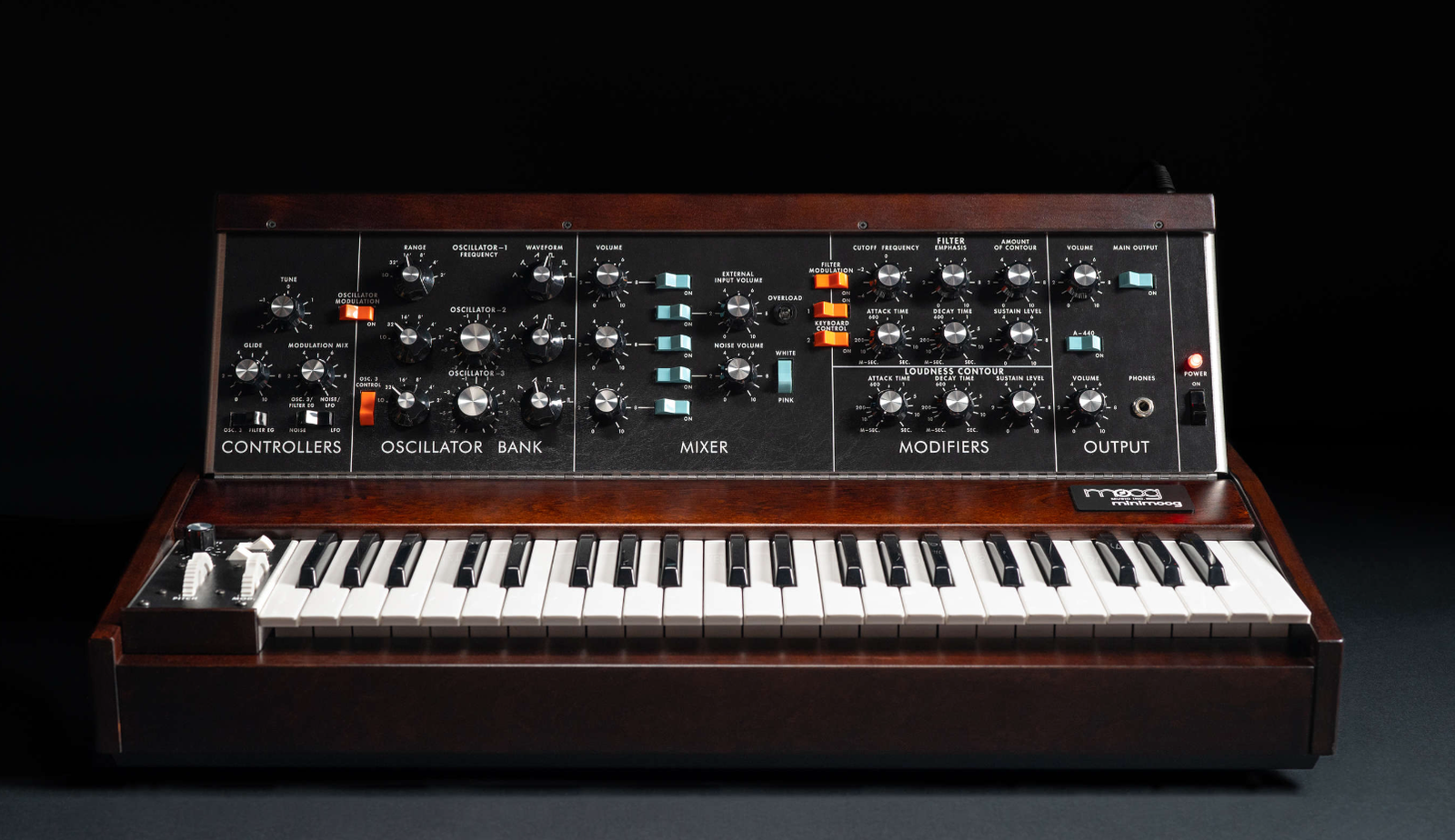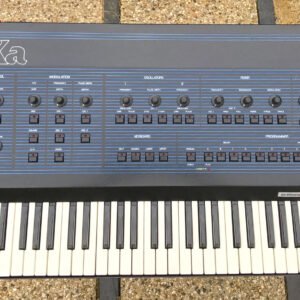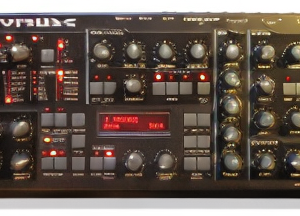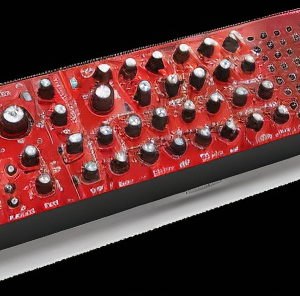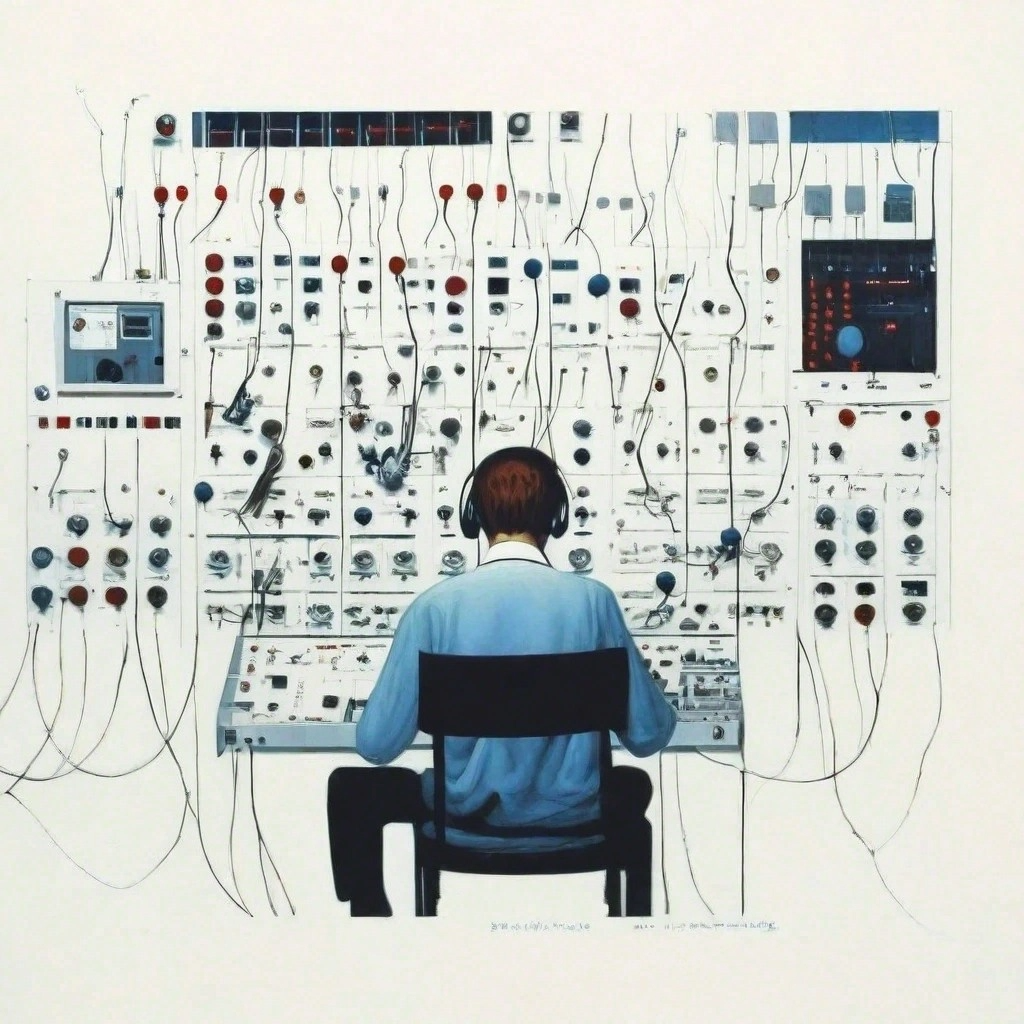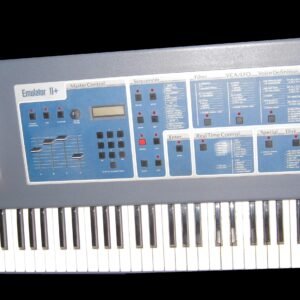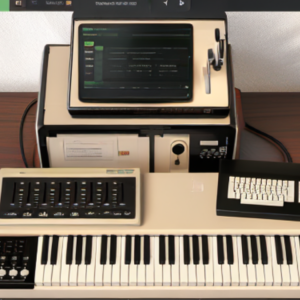Moog minimoog
The Moog MiniMoog stands as a timeless icon in the realm of synthesizers, revered for its pioneering role in shaping electronic music. Introduced in the early 1970s, the MiniMoog quickly became synonymous with the distinctive analog sound that defined an era. Its compact size, intuitive interface, and powerful sound capabilities revolutionized the way musicians approached electronic music production.
At the heart of the MiniMoog’s allure is its rich heritage, tracing back to the visionary work of Dr. Robert Moog, the founder of Moog Music. Dr. Moog’s groundbreaking innovations in electronic music technology laid the foundation for the MiniMoog’s creation. Drawing upon his expertise in analog circuitry and oscillators, the MiniMoog emerged as a testament to Moog’s commitment to pushing the boundaries of sonic exploration.
With its compact design and portable form factor, the MiniMoog offered musicians unprecedented accessibility to the world of synthesis. Its intuitive layout, featuring knobs and switches for real-time control over parameters, empowered artists to sculpt and shape sounds with immediacy and precision. From fat basslines to soaring leads, the MiniMoog’s versatile sound palette catered to a wide range of musical styles and genres, cementing its status as a staple in both studio and live performance settings.
Beyond its technical capabilities, the MiniMoog embodies a spirit of innovation and creativity that continues to resonate with musicians and enthusiasts alike. Its influence can be heard across countless recordings, spanning genres from electronic and pop to rock and beyond. From pioneering electronic artists to mainstream musicians, the MiniMoog’s distinctive timbre has left an indelible mark on the fabric of modern music.
As we delve deeper into the design, features, and sonic capabilities of the MiniMoog, we embark on a journey through the rich tapestry of electronic music history. Join us as we explore the legacy of this iconic synthesizer and celebrate its enduring impact on the world of music.
Design and Features
The design of the Moog MiniMoog is as iconic as its sound, characterized by its compact yet robust construction and intuitive layout. Let’s delve into the key design elements and features that have made the MiniMoog a legendary instrument in the world of synthesizers.
Compact Form Factor: The MiniMoog’s design prioritizes portability without compromising on sound quality or functionality. Its compact dimensions make it easy to transport and integrate into any studio setup or live performance rig.
Wooden Exterior: One of the most distinctive aspects of the MiniMoog’s design is its wooden exterior, which adds a touch of vintage elegance to its appearance. The wood paneling not only enhances the instrument’s aesthetic appeal but also contributes to its durability and resilience.
Control Panel: At the heart of the MiniMoog lies its intuitive control panel, featuring an array of knobs, switches, and sliders that provide tactile control over every aspect of sound creation. This hands-on approach to synthesis allows musicians to interact with the instrument in real-time, shaping sounds with precision and expressiveness.
Three Oscillators: The MiniMoog is equipped with three voltage-controlled oscillators (VCOs), each capable of generating rich, harmonically complex waveforms. This versatile oscillator section allows for the creation of a wide range of timbres, from thick bass tones to shimmering leads and intricate textures.
Voltage-Controlled Filter (VCF): Central to the MiniMoog’s signature sound is its legendary voltage-controlled filter, which offers a distinctive warmth and character that is coveted by musicians and producers alike. The VCF can be modulated dynamically using various modulation sources, enabling expressive sound shaping and manipulation.
Envelopes and Modulation: The MiniMoog features dedicated envelope generators for controlling amplitude (ADSR) and filter cutoff (ADSR), providing precise control over the shape and dynamics of sounds. Additionally, a versatile modulation section allows for the creation of evolving textures and dynamic timbral changes through the use of modulation sources such as LFOs and external control sources.
Patch Points: For enhanced connectivity and modulation capabilities, the MiniMoog offers a comprehensive patching system with a range of input and output jacks. These patch points allow for complex signal routing and modulation possibilities, enabling musicians to explore new sonic territories and expand the instrument’s sonic palette.
Built-In Keyboard: Unlike its modular predecessors, the MiniMoog features a built-in 44-note keyboard, providing immediate access to playable musical pitches and facilitating live performance and improvisation.
Overall, the design and features of the Moog MiniMoog reflect a commitment to craftsmanship, innovation, and sonic excellence. From its timeless aesthetic to its unparalleled sound capabilities, the MiniMoog continues to inspire musicians and electronic music enthusiasts around the world, cementing its status as a true legend in the realm of synthesizers.
Sound Generation:
At the heart of the Moog MiniMoog’s legendary status lies its exceptional sound generation capabilities, which have played a pivotal role in shaping the landscape of electronic music. Let’s delve into the core components and processes involved in sound generation on the MiniMoog, exploring the unique characteristics that have made it a staple in studios and on stages worldwide.
Voltage-Controlled Oscillators (VCOs): The MiniMoog features three voltage-controlled oscillators (VCOs), each capable of generating a variety of waveforms, including sawtooth, square, and triangle waves. These oscillators serve as the primary sound sources, providing the foundation for creating rich and complex timbres.
Waveform Mixing: One of the defining features of the MiniMoog’s sound generation is its ability to mix and blend different waveforms from the three oscillators. By adjusting the mixer controls, musicians can create unique combinations of waveforms, enabling the creation of rich harmonic content and dynamic textures.
Frequency Modulation (FM): The MiniMoog offers frequency modulation capabilities, allowing for the modulation of oscillator frequencies to create dynamic and evolving timbral changes. By applying modulation from sources such as the modulation oscillator or external sources, musicians can achieve expressive and organic sound variations.
Voltage-Controlled Filter (VCF): Central to the MiniMoog’s iconic sound is its legendary voltage-controlled filter (VCF), which shapes the harmonic content and timbral characteristics of the generated sounds. The filter’s cutoff frequency and resonance controls allow for precise manipulation of the frequency spectrum, from deep bass tones to bright, resonant leads.
Filter Envelope: The MiniMoog features a dedicated envelope generator for controlling the voltage-controlled filter (VCF), shaping the filter’s behavior over time. By adjusting the envelope parameters such as attack, decay, sustain, and release, musicians can sculpt the filter’s response to create dynamic and expressive sounds.
Amplitude Envelope: In addition to the filter envelope, the MiniMoog includes a dedicated amplitude envelope generator, which controls the overall volume and amplitude of the generated sounds. The amplitude envelope parameters enable musicians to shape the dynamics and contour of sounds, from sharp staccato attacks to smooth, sustained tones.
Modulation Capabilities: To further enhance sound generation possibilities, the MiniMoog offers a range of modulation capabilities, including low-frequency oscillators (LFOs) and modulation sources. These modulation sources can be routed to various parameters such as oscillator pitch, filter cutoff, and amplifier level, adding movement, depth, and expression to the generated sounds.
Warmth and Character: Beyond its technical specifications, what truly sets the MiniMoog apart is its unparalleled warmth, character, and sonic personality. The combination of analog circuitry, discrete components, and careful tuning results in a sound that is rich, vibrant, and inherently musical, making the MiniMoog a timeless instrument cherished by musicians and producers across generations.
In summary, the Moog MiniMoog’s sound generation capabilities represent the pinnacle of analog synthesis, offering a rich and dynamic sonic palette that continues to inspire creativity and innovation in electronic music production. From its iconic oscillators and filters to its expressive modulation capabilities, the MiniMoog remains a cornerstone of electronic music history, beloved for its unparalleled sound and enduring legacy.
Technical Specifications:
Here are the detailed technical specifications for the Moog MiniMoog synthesizer:
Oscillators:
Three voltage-controlled oscillators (VCOs)
Waveforms: Sawtooth, Square, Triangle
Octave Range: 32′, 16′, 8′, 4′, 2′
Tuning: Variable +/- 7 semitones
Frequency Modulation (FM) capabilities
Mixer Section:
Mixer for blending and mixing the output of the three oscillators
Control knobs for adjusting the level of each oscillator
Voltage-Controlled Filter (VCF):
Legendary 24 dB/octave low-pass filter
Cutoff Frequency control knob
Resonance control knob for emphasizing harmonic content
Envelope Amount control for modulation of filter cutoff
Envelope Generators:
Filter Envelope:
Attack, Decay, Sustain, Release (ADSR) parameters
Controls the behavior of the voltage-controlled filter
Amplitude Envelope:
Attack, Decay, Sustain, Release (ADSR) parameters
Controls the overall volume and dynamics of the sound
Modulation Section:
Low-Frequency Oscillator (LFO) for modulation purposes
Modulation sources for routing to oscillator pitch, filter cutoff, and amplifier level
Modulation depth controls for adjusting the intensity of modulation
Keyboard:
44-note keyboard with velocity sensitivity
Octave range selector switches
Patch Points:
Comprehensive patching system with input and output jacks
Allows for complex signal routing and modulation possibilities
Control Interface:
Wooden control panel with tactile knobs, switches, and sliders
Intuitive layout for real-time sound shaping and manipulation
Ergonomic design for ease of use in studio and live performance settings
Connectivity:
Audio Output: 1/4″ TRS jack
Control Voltage (CV) inputs and outputs for interfacing with external modular gear
Gate inputs and outputs for triggering and syncing with external devices
Power:
Standard AC power adapter
Compatible with various voltages for international use
Dimensions and Weight:
Dimensions: Approx. 24.5″ x 13.75″ x 6.5″ (W x D x H)
Weight: Approx. 20 lbs (9 kg)
Construction:
Robust construction with a durable metal chassis
Wooden side panels for added durability and aesthetic appeal
These technical specifications highlight the Moog MiniMoog’s exceptional capabilities and craftsmanship, making it a versatile and reliable instrument for musicians, producers, and sound designers alike. With its rich analog sound, intuitive interface, and timeless design, the MiniMoog continues to inspire creativity and innovation in electronic music production.
Performance and Workflow
The Moog MiniMoog’s performance and workflow capabilities are designed to provide musicians with a seamless and intuitive experience, whether in the studio or on stage. Let’s explore how its ergonomic design, versatile features, and real-time controls contribute to an immersive and inspiring performance environment.
Ergonomic Design: The MiniMoog’s compact and robust design makes it well-suited for both studio and live performance settings. Its wooden exterior, tactile knobs, and sturdy construction ensure durability and reliability, while its portable form factor allows for easy transport and setup.
Real-Time Control: One of the key strengths of the MiniMoog is its hands-on control interface, featuring an array of knobs, switches, and sliders for real-time manipulation of sound parameters. This intuitive layout empowers musicians to sculpt and shape sounds on the fly, enabling expressive performances with a tangible connection to the instrument.
Immediate Access to Parameters: With its straightforward control panel layout, the MiniMoog provides immediate access to essential parameters such as oscillator tuning, filter cutoff, resonance, and envelope settings. This streamlined workflow allows musicians to focus on their creative vision without getting bogged down by complex menu diving or software interfaces.
Expressive Playing Experience: The MiniMoog’s built-in keyboard offers a responsive and dynamic playing experience, with velocity sensitivity adding nuance and expressiveness to performances. Musicians can explore a wide range of playing techniques, from delicate fingerwork to bold and expressive gestures, all with the immediacy and responsiveness that analog synthesis provides.
Patch Memory and Recall: While the MiniMoog is primarily an analog instrument, modern iterations may offer patch memory and recall capabilities, allowing users to save and recall their favorite sound presets for quick and easy access during performances or studio sessions. This feature enhances workflow efficiency and flexibility, enabling seamless integration into larger setups and productions.
Integration with External Gear: The MiniMoog’s comprehensive patching system and connectivity options make it ideal for interfacing with external modular gear, effects processors, sequencers, and MIDI controllers. Musicians can expand the instrument’s sonic capabilities and creative potential by integrating it into larger modular setups or hybrid digital/analog workflows.
Live Performance Capabilities: Whether as a standalone instrument or as part of a larger synthesizer rig, the MiniMoog shines in live performance scenarios. Its rugged construction, responsive controls, and iconic sound make it a favorite among keyboardists, synthesists, and electronic musicians for delivering captivating and memorable live performances.
Studio Versatility: In the studio, the MiniMoog’s rich analog sound and versatile synthesis capabilities make it an indispensable tool for music production, sound design, and experimentation. From crafting fat basslines and soaring leads to sculpting intricate textures and soundscapes, the MiniMoog offers endless creative possibilities for musicians and producers.
In summary, the Moog MiniMoog’s performance and workflow capabilities are a testament to its timeless design, intuitive interface, and exceptional sound quality. Whether in the studio or on stage, the MiniMoog empowers musicians to unleash their creativity and expressiveness, forging new sonic territories and leaving a lasting impact on electronic music history.
Notable Users and Influences
The Moog MiniMoog’s impact on the world of music extends far beyond its technical specifications and design features. Its distinctive sound and intuitive interface have attracted a diverse array of notable users, ranging from pioneering electronic artists to mainstream musicians across various genres. Let’s explore some of the influential musicians who have embraced the MiniMoog and the lasting influence it has had on their music and the broader musical landscape.
Keith Emerson: Renowned for his virtuosic keyboard skills and groundbreaking work with the progressive rock band Emerson, Lake & Palmer, Keith Emerson was an early adopter of the MiniMoog. His iconic performances featuring the MiniMoog helped popularize the synthesizer as a versatile and expressive instrument capable of producing a wide range of sounds, from lush orchestral textures to blistering lead lines.
Stevie Wonder: Grammy-winning singer, songwriter, and multi-instrumentalist Stevie Wonder incorporated the MiniMoog into his pioneering blend of soul, funk, and pop music. His use of the synthesizer on albums like “Innervisions” and “Songs in the Key of Life” helped push the boundaries of traditional keyboard instrumentation, paving the way for future generations of electronic music artists.
Herbie Hancock: Jazz fusion pioneer Herbie Hancock embraced the MiniMoog’s sonic capabilities on landmark albums such as “Head Hunters” and “Thrust.” His innovative approach to synthesis and improvisation showcased the instrument’s versatility and adaptability across diverse musical contexts, solidifying its status as a staple in jazz and fusion music.
Kraftwerk: German electronic music pioneers Kraftwerk integrated the MiniMoog into their pioneering electronic compositions, helping define the sound of electronic music in the 1970s and beyond. Their use of the synthesizer on albums like “Autobahn” and “Trans-Europe Express” demonstrated its potential for creating hypnotic rhythms, futuristic textures, and otherworldly atmospheres.
Gary Numan: British synth-pop icon Gary Numan’s use of the MiniMoog on hits like “Cars” and “Are ‘Friends’ Electric?” helped popularize synthesizers in mainstream music during the late 1970s and early 1980s. His distinctive blend of icy synthesizer melodies, pulsating basslines, and dystopian lyrics became synonymous with the emerging new wave and synth-pop movements.
Tangerine Dream: Pioneering electronic music group Tangerine Dream embraced the MiniMoog as a central element of their atmospheric and cinematic soundscapes. Their use of the synthesizer on albums like “Phaedra” and “Rubycon” helped define the genre of ambient music and influenced generations of electronic artists and composers.
Giorgio Moroder: Italian producer and electronic music pioneer Giorgio Moroder utilized the MiniMoog to create groundbreaking disco and electronic dance music tracks in the 1970s and 1980s. His use of the synthesizer on hits like “I Feel Love” by Donna Summer showcased its potential for creating pulsating basslines, shimmering arpeggios, and hypnotic rhythms, shaping the sound of dance music for decades to come.
Depeche Mode: British electronic band Depeche Mode incorporated the MiniMoog into their distinctive blend of synth-pop, new wave, and alternative rock. Keyboardist and songwriter Martin Gore’s use of the synthesizer on classic albums like “Violator” and “Music for the Masses” contributed to the band’s dark and atmospheric sound, earning them a devoted global following.
These notable users and influences represent just a fraction of the artists who have embraced the Moog MiniMoog and contributed to its enduring legacy in the world of music. From progressive rock and jazz fusion to electronic dance music and beyond, the MiniMoog’s timeless sound continues to inspire creativity, innovation, and musical exploration across genres and generations.
Impact and Legacy:
The Moog MiniMoog’s impact on the world of music is immeasurable, having left an indelible mark on the evolution of electronic music and shaping the sonic landscape for generations to come. Its revolutionary design, iconic sound, and intuitive interface have cemented its status as one of the most influential synthesizers in history. Let’s explore the profound impact and enduring legacy of the MiniMoog:
Revolutionizing Electronic Music: The introduction of the MiniMoog in the early 1970s marked a paradigm shift in electronic music production. Its portable form factor, versatile sound generation capabilities, and intuitive control interface democratized access to synthesis, empowering musicians to explore new sonic territories and break free from the constraints of traditional keyboard instruments.
Popularizing Synthesizers: The MiniMoog played a pivotal role in popularizing synthesizers as viable musical instruments in mainstream music production. Its distinctive analog sound became synonymous with the emerging genres of electronic, synth-pop, and new wave, influencing countless artists and producers to incorporate synthesizers into their music.
Shaping Musical Genres: From progressive rock and jazz fusion to disco, synth-pop, and beyond, the MiniMoog’s influence can be heard across a wide range of musical genres. Its rich and versatile sound palette, characterized by fat basslines, soaring leads, and shimmering textures, helped define the sonic aesthetic of the 1970s and 1980s and continues to inspire contemporary artists across diverse musical landscapes.
Innovation and Experimentation: The MiniMoog’s modular design and patching capabilities encouraged experimentation and innovation among musicians and sound designers. Its open-ended architecture enabled artists to create custom signal routings, modulations, and timbral variations, pushing the boundaries of sonic exploration and paving the way for future advancements in synthesis technology.
Cultural Icon: Beyond its technical specifications, the MiniMoog holds a special place in popular culture as a symbol of innovation, creativity, and artistic expression. Its iconic design, immortalized in album covers, music videos, and stage performances, has become synonymous with the futuristic aesthetic of electronic music and remains instantly recognizable to music enthusiasts worldwide.
Enduring Influence: Despite decades of technological advancements in digital synthesis and software-based instruments, the MiniMoog’s timeless sound and tactile interface continue to resonate with musicians and producers of all backgrounds. Its warm, analog timbres and hands-on control interface evoke a sense of nostalgia and authenticity that cannot be replicated by digital emulations, ensuring its continued relevance in today’s music production landscape.
Collector’s Item: Due to its historical significance and cultural impact, the MiniMoog has become a highly sought-after collector’s item among synthesizer enthusiasts and vintage gear aficionados. Well-preserved examples of the MiniMoog command premium prices on the vintage market, attesting to its enduring appeal and iconic status in the annals of music history.
In summary, the Moog MiniMoog’s impact and legacy extend far beyond its technical specifications, encompassing its role as a catalyst for musical innovation, a cultural icon, and a symbol of artistic expression. Its influence can be felt across genres, generations, and continents, making it a true legend in the world of electronic music and a source of inspiration for generations of musicians and music lovers alike.
Collector's Value and Market Trends
The Moog MiniMoog holds a revered status among synthesizer enthusiasts and collectors, making it a highly coveted item on the vintage gear market. Its historical significance, iconic design, and legendary sound have contributed to its enduring appeal and escalating collector’s value. Let’s explore the factors driving the MiniMoog’s collector’s value and current market trends:
Historical Significance: As one of the first portable synthesizers to gain widespread popularity, the MiniMoog holds a significant place in the history of electronic music. Its introduction in the early 1970s revolutionized music production and performance, laying the groundwork for subsequent generations of synthesizers and shaping the sonic landscape of popular music.
Limited Availability: Despite being produced in relatively large numbers during its production run, the Moog MiniMoog is now considered a rare and sought-after item due to its age and limited availability in the vintage market. Well-preserved examples in good working condition command premium prices among collectors and enthusiasts.
Iconic Design and Aesthetic Appeal: The MiniMoog’s timeless design, featuring wooden side panels, tactile knobs, and a sleek control panel layout, adds to its aesthetic appeal and collector’s value. Its vintage charm and retro-futuristic aesthetic evoke a sense of nostalgia for the golden age of analog synthesis, making it a prized addition to any vintage gear collection.
Legendary Sound Quality: Perhaps the most significant factor driving the MiniMoog’s collector’s value is its legendary sound quality and sonic character. Its rich, warm analog tones, distinctive filter sweeps, and expressive modulation capabilities have stood the test of time, earning it a revered status among musicians, producers, and sound designers.
Celebrity Associations: The MiniMoog’s association with influential artists and bands, such as Keith Emerson, Stevie Wonder, and Kraftwerk, further enhances its collector’s value and cultural cachet. Its presence on iconic recordings and live performances has solidified its status as a must-have instrument for serious collectors and enthusiasts.
Market Trends: In recent years, the demand for vintage synthesizers, including the MiniMoog, has surged, driving up prices in the vintage gear market. Collectors and investors alike are willing to pay a premium for well-maintained examples of the MiniMoog, particularly those with documented provenance or unique historical significance.
Restoration and Maintenance: Due to the age of many MiniMoog synthesizers on the market, restoration and maintenance play a crucial role in determining their collector’s value. Instruments that have been meticulously restored, refurbished, or upgraded by reputable technicians may command higher prices and attract discerning buyers looking for pristine examples.
Future Outlook: As the vintage gear market continues to evolve and expand, the MiniMoog’s collector’s value is expected to remain strong, fueled by ongoing interest from musicians, collectors, and vintage synthesizer enthusiasts. Its timeless appeal, historical significance, and legendary sound ensure that the MiniMoog will remain a highly sought-after instrument for years to come.
In summary, the Moog MiniMoog’s collector’s value and market trends reflect its status as a cultural icon and a pioneering instrument in the world of electronic music. With its timeless design, legendary sound, and enduring legacy, the MiniMoog continues to captivate the imaginations of collectors and enthusiasts worldwide, solidifying its place as one of the most iconic synthesizers in history.
Innovations and Contributions
The Moog MiniMoog stands as a testament to innovation and creativity in the realm of electronic music, boasting several groundbreaking features and contributions that have shaped the course of musical history. Let’s explore the innovations and contributions of the MiniMoog:
Portable Design: One of the most significant innovations of the MiniMoog was its portable and compact design. Unlike previous modular synthesizers, which were large, cumbersome, and often confined to studio environments, the MiniMoog’s portable form factor allowed musicians to take it on the road and incorporate it into live performances. This newfound mobility revolutionized the way synthesizers were used and opened up new creative possibilities for musicians.
Integrated Control Interface: The MiniMoog introduced an intuitive and user-friendly control interface, featuring tactile knobs, switches, and sliders that provided immediate access to essential synthesis parameters. This hands-on approach to sound shaping and manipulation empowered musicians to interact with the instrument in real-time, facilitating expressive performances and spontaneous sonic exploration.
Voltage-Controlled Oscillators (VCOs): The MiniMoog’s three voltage-controlled oscillators (VCOs) offered a versatile and dynamic sound generation engine, capable of producing a wide range of harmonically rich waveforms, including sawtooth, square, and triangle waves. This innovative oscillator design provided musicians with unprecedented control over pitch, timbre, and modulation, laying the foundation for the analog synthesis techniques that would define electronic music for decades to come.
Legendary Filter Design: Central to the MiniMoog’s iconic sound was its legendary 24 dB/octave voltage-controlled filter (VCF), which offered a distinctive warmth, character, and expressiveness that set it apart from other synthesizers of its time. The filter’s smooth and musical resonance, coupled with its dynamic response to modulation, became synonymous with the MiniMoog’s signature sound and left an indelible mark on electronic music history.
Real-Time Performance Capabilities: The MiniMoog’s responsive keyboard, expressive modulation options, and immediate access to sound parameters made it an ideal instrument for live performance and improvisation. Musicians could sculpt and shape sounds on the fly, creating dynamic textures, evolving timbres, and captivating performances that captivated audiences and pushed the boundaries of what was possible with electronic music.
Pioneering Artists and Influences: The MiniMoog’s innovations and contributions to electronic music are reflected in its widespread adoption by pioneering artists and bands across various genres. From progressive rock and jazz fusion to disco, synth-pop, and beyond, the MiniMoog’s influence can be heard on countless recordings and live performances, shaping the sonic landscape of popular music and inspiring generations of musicians and producers.
Legacy of Innovation: Beyond its immediate impact, the MiniMoog’s legacy of innovation and creativity continues to resonate with musicians, synthesizer enthusiasts, and electronic music producers worldwide. Its timeless design, legendary sound, and enduring legacy serve as a source of inspiration for future generations of instrument designers, pushing the boundaries of what is possible with synthesis and electronic music technology.
In summary, the Moog MiniMoog’s innovations and contributions to electronic music are far-reaching and profound, with its portable design, integrated control interface, voltage-controlled oscillators, legendary filter design, and real-time performance capabilities redefining the possibilities of analog synthesis and shaping the course of musical history. As a pioneering instrument that continues to inspire creativity and innovation, the MiniMoog remains a timeless icon in the world of electronic music.
Conclusion
The Moog MiniMoog stands as a timeless icon in the realm of synthesizers, embodying a legacy of innovation, creativity, and musical excellence that has left an indelible mark on the world of electronic music. From its revolutionary design and pioneering features to its legendary sound and enduring legacy, the MiniMoog continues to inspire generations of musicians, producers, and synthesizer enthusiasts worldwide.
Throughout its storied history, the MiniMoog has been at the forefront of electronic music innovation, introducing groundbreaking features such as portable design, integrated control interface, voltage-controlled oscillators, and legendary filter design that have redefined the possibilities of analog synthesis and shaped the sonic landscape of popular music.
Its influence can be heard in the iconic recordings of pioneering artists and bands across genres, from progressive rock and jazz fusion to disco, synth-pop, and beyond. Artists such as Keith Emerson, Stevie Wonder, Kraftwerk, and countless others have embraced the MiniMoog’s distinctive sound and intuitive interface, incorporating it into their music and pushing the boundaries of sonic exploration.
As a cultural icon and symbol of innovation, the MiniMoog’s legacy extends far beyond its technical specifications, encompassing its role as a catalyst for musical creativity, a source of inspiration for future generations of musicians, and a testament to the enduring power of analog synthesis.
In conclusion, the Moog MiniMoog remains a timeless masterpiece, cherished for its iconic design, legendary sound, and lasting impact on the world of electronic music. Whether in the studio or on stage, the MiniMoog continues to captivate audiences and inspire artists to push the boundaries of sonic possibility, ensuring its place as a true legend in the annals of music history.
